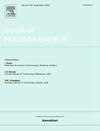Superiority of clay composite materials of bentonite intercalated with the bimetallic MOFs-Pb/Cu, and nano magnetite to enhance the gamma and neutron radiation shielding
IF 2.3
3区 工程技术
Q1 NUCLEAR SCIENCE & TECHNOLOGY
引用次数: 0
Abstract
In this study, a series of ternary nanocomposite materials were developed by integrating bentonite clay with nano magnetite and bimetallic metal–organic frameworks (MOFs) based on Pb/Cu and tartaric acid as organic linker. These composites were synthesized in varying compositions and systematically evaluated through both experimental techniques and theoretical modeling for their gamma radiation shielding performance. The composites were formulated with fixed proportions of 40.0 % bentonite as a base material with varying ratios of MOFs and nano magnetite specifically: (60.0–X) % bimetallic Pb/Cu-MOFs and X% nano magnetite, where X = 45.0 %, 30.0 %, and 15.0 %. These formulations are denoted as [B40MPCXMG(60-X)]. Comprehensive characterization of the base material of bentonite, and the Pb/Cu-MOFs was conducted using FT-IR, Raman, XRD, XRF, and HR-TEM tests. The radiation shielding properties of the composites were then assessed using Monte Carlo simulation code (MC) and Phy-X software across a broad photon energy range (0.015–15.0 MeV). Key shielding parameters were calculated to evaluate the shielding effectiveness. The results revealed that the MOF-Pb/Cu content controls either the γ-radiation and neutron attenuation performance in the prepared B40MPCXMG(60-X) nano-composites. The B40MPC45MG15 sample exhibited the highest linear attenuation coefficient for gamma radiation among the prepared composites, along with the lowest values of H/TVL. Additionally,the B40MPC30MG30 sample demonstrated the highest fast neutron removal cross-section among the prepared composites. The B40MPC30MG30 sample is recommended as the optimal composition for superior shielding performance against both gamma rays and neutrons.

膨润土嵌层pb /Cu双金属mofs和纳米磁铁矿增强γ和中子辐射屏蔽的优越性
本研究将膨润土粘土与纳米磁铁矿和基于Pb/Cu的双金属金属有机骨架(MOFs)结合,以酒石酸为有机连接剂,制备了一系列三元复合材料。这些复合材料以不同的成分合成,并通过实验技术和理论模型系统地评估了它们的伽马辐射屏蔽性能。复合材料以固定比例为40.0%的膨润土为基料,加入不同比例的mof和纳米磁铁矿,即(60.0-X) %双金属Pb/ cu - mof和X%纳米磁铁矿,其中X = 45.0%, 30.0%和15.0%。这些配方用[B40MPCXMG(60-X)]表示。利用FT-IR、Raman、XRD、XRF和HR-TEM等测试手段对基材膨润土和Pb/Cu-MOFs进行了综合表征。然后使用蒙特卡罗模拟代码(MC)和Phy-X软件在宽光子能量范围(0.015-15.0 MeV)内评估复合材料的辐射屏蔽性能。计算了关键屏蔽参数,评价了屏蔽效果。结果表明,MOF-Pb/Cu含量控制着B40MPCXMG(60-X)纳米复合材料的γ辐射和中子衰减性能。在制备的复合材料中,B40MPC45MG15样品的伽马辐射线性衰减系数最高,H/TVL最小。此外,B40MPC30MG30样品在制备的复合材料中表现出最高的快中子去除截面。B40MPC30MG30样品被推荐为对伽马射线和中子具有卓越屏蔽性能的最佳成分。
本文章由计算机程序翻译,如有差异,请以英文原文为准。
求助全文
约1分钟内获得全文
求助全文
来源期刊

Annals of Nuclear Energy
工程技术-核科学技术
CiteScore
4.30
自引率
21.10%
发文量
632
审稿时长
7.3 months
期刊介绍:
Annals of Nuclear Energy provides an international medium for the communication of original research, ideas and developments in all areas of the field of nuclear energy science and technology. Its scope embraces nuclear fuel reserves, fuel cycles and cost, materials, processing, system and component technology (fission only), design and optimization, direct conversion of nuclear energy sources, environmental control, reactor physics, heat transfer and fluid dynamics, structural analysis, fuel management, future developments, nuclear fuel and safety, nuclear aerosol, neutron physics, computer technology (both software and hardware), risk assessment, radioactive waste disposal and reactor thermal hydraulics. Papers submitted to Annals need to demonstrate a clear link to nuclear power generation/nuclear engineering. Papers which deal with pure nuclear physics, pure health physics, imaging, or attenuation and shielding properties of concretes and various geological materials are not within the scope of the journal. Also, papers that deal with policy or economics are not within the scope of the journal.
 求助内容:
求助内容: 应助结果提醒方式:
应助结果提醒方式:


